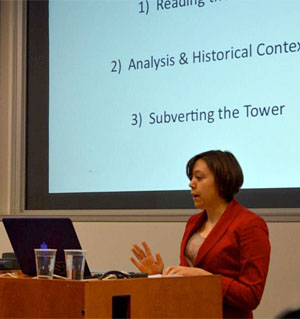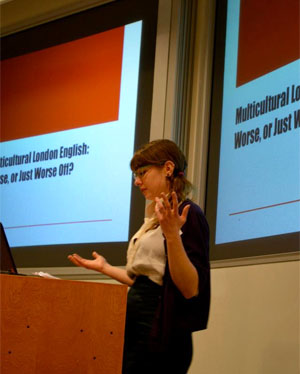Dalhousie’s annual undergraduate conference in Arts and Social Sciences isn’t just for Dal students: it’s a national conference, with participation from across Canada.
Held on March 8 and 9, the fourth-annual conference brought together students from all different backgrounds and disciplines in the Rowe Building to present and discuss a wide range of topics, from IDS to philosophy, history to sociology and social anthropology.
“We were aiming for quality papers and potential for interesting presentations that may generate some discussion,” explained committee member Caitlyn Weird, a third-year student in Gender and Women’s Studies and Environmental Science. The applications were read blind — without knowing the students’ name or university — but the committee still ended up with cross-country representation.
Diverse presentations
The Saturday of the conference itself was divided into two sections, the first being held shortly after 9 for International Development Studies, Political Science and History topics. Each category was assigned a room where students could go and listen to two different papers/presentations on a specific discipline.
The presentations were as diverse and captivating as the students giving them. The IDS section included examination of FGC eradication in Africa by Stephanie Wan from McMaster University and a paper entitled “Hanging Around: From Sacrifice to Sublimation” by King’s College student Talia Isaacson. Political Science goers heard a presentation by Dal’s Sam Viessing on the “Polarization between Elephants and Donkeys” and, in the History session, Katelyn Arac of St. Francis Xavier presented a paper close to her heart: how contact with the Europeans has forever altered the Inuit and Déné peoples.
 After her presentation Arac explained that she had worked with Inuit peoples in the Northwest Territories and became interested in their culture; this paper was a testament to how that culture continues to be sacrificed over time. King’s student Samantha Elmsley (left) also took a passionate stance when presenting her paper on Memorial Tower: a historical landmark and statue that Elmsley has some qualms with, specifically its representation, or lack thereof of native Mi'kmaq peoples and their place in historical memory. Elmsley took her research so far as to create guerrilla art by making her own plaque and putting it on the tower. She also had QR code made up and placed it on the entrance plaque of the park, so anyone with a smart phone can scan the code and it will instantly direct that person to the public library archives and history of the native peoples.
After her presentation Arac explained that she had worked with Inuit peoples in the Northwest Territories and became interested in their culture; this paper was a testament to how that culture continues to be sacrificed over time. King’s student Samantha Elmsley (left) also took a passionate stance when presenting her paper on Memorial Tower: a historical landmark and statue that Elmsley has some qualms with, specifically its representation, or lack thereof of native Mi'kmaq peoples and their place in historical memory. Elmsley took her research so far as to create guerrilla art by making her own plaque and putting it on the tower. She also had QR code made up and placed it on the entrance plaque of the park, so anyone with a smart phone can scan the code and it will instantly direct that person to the public library archives and history of the native peoples.
 The second section of presentations covered Sociology and Social Anthropology, Philosophy, and Language and Literature. Papers ranged from topics such as “Celtic Community,” a colourful exploration made by Cape Breton University’s Malie Graham-Laidlaw; a deeper look into the Autism spectrum from Margaret Tilt, research born outside of the classroom from her work with children; Grant MacEwan University’s Daniel Cook’s look at the “Philosophy of Failure”; Reed Clements’s apt “This is Not a Paper”; and Dal’s own Alicia Niemann (right), who ended with a controversial and humorous look at MLE (Multicultural London English), asking if it’s nature or nurture that most informs youth culture and exploring how slang and creativity play off one another.
The second section of presentations covered Sociology and Social Anthropology, Philosophy, and Language and Literature. Papers ranged from topics such as “Celtic Community,” a colourful exploration made by Cape Breton University’s Malie Graham-Laidlaw; a deeper look into the Autism spectrum from Margaret Tilt, research born outside of the classroom from her work with children; Grant MacEwan University’s Daniel Cook’s look at the “Philosophy of Failure”; Reed Clements’s apt “This is Not a Paper”; and Dal’s own Alicia Niemann (right), who ended with a controversial and humorous look at MLE (Multicultural London English), asking if it’s nature or nurture that most informs youth culture and exploring how slang and creativity play off one another.
Sharing achievements
Each student who presented his or her research also had the opportunity to discuss and engage with the audience and moderators, encouraging critical thinking and analysis on topics that each student was passionate about.
“I think that this event is important because it gives undergraduate students who have taken an Arts and Social Sciences class to display some of their achievements,” said Weir. “There aren't very many opportunities to showcase undergraduate work. This conference is a fun and accepting place to gain a little practice in presenting skills – not to mention, for those who planned the event, some good team-building and organizing skills.”
And it showed. The students who ran the conference that day were efficient and friendly, well-organized and professional. The event was carefully thought out — from what was presented, to who the moderators were, to events for out-of-town students to attend. There was a large gap in the day after the presentations, and organizers had set up several options for students from skating at the oval, to attending a brewery tour to going to the Maritime Museum.
“It took a lot of work. Katherine Strynatka (DASSS VP Academic) put a lot of effort into organizing this event, as did Andrew Swift (DASSS Pres) and the entire committee,” said Weir.
“I'm not sure what the future goals for the conference are,” she adds. “I think at this point we would like to see this conference simply continue as it is.The conference this year took a lot of time to plan, on top of the already busy schedules of the students involved in organizing. It would be nice to see this conference grow.”

